When it comes to sonic excellence, audiophiles will go to any length to achieve the perfect sound. Audiophile headphones, renowned for their unrivaled audio quality and precision, have emerged as the go-to option for those who expect nothing less than the best.
However, one common issue that audiophiles face is the requirement for a headphone amplifier (amp) to maximize the performance of their premium headphones.
This blog will take us on a journey to find a solution to this quandary. We will delve into the world of audiophile headphones that do not need an external amplifier to deliver breathtaking audio experiences.
This guide will help you navigate the best options available, whether you are a seasoned audiophile or just starting out in the world of high-fidelity sound.
We will look at the characteristics that define audiophile headphones, debunk the situations in which an amp is required, and reveal our top picks for headphones that can stand alone in terms of audio quality.
In addition, we will offer advice on how to get the most out of these amp-free headphones and answer some frequently asked questions.
So, if you are ready to embark on a journey to audio nirvana without the added weight of extra gear, let us delve into the world of the best audiophile headphones that do not require an amp.
The Ultimate Guide to Audiophile Headphones That Don’t Need an Amp
In This Topic we will Cover:-
- What Exactly Are Audiophile Headphones
- When Do You Need a Headphone Amp
- The Selection Criteria for Amp-Free Audiophile Headphones
- Best Audiophile Headphones Without an Amplifier
- How to Maximize the Performance of Your Amp-Free Audiophile Headphones
1. What Exactly Are Audiophile Headphones?

In the world of personal audio, audiophile headphones are a breed apart. They are meticulously engineered to provide the most accurate and immersive listening experiences, making them the preferred choice for sound quality enthusiasts.
Here, we will look at the distinguishing features of these exceptional headphones and discover why they have such a special place in the hearts of music fans.
A. Characteristics and Definition
High-Fidelity Audio: Audiophile headphones are designed to faithfully reproduce sound as the artist intended. They excel at producing a broad frequency range, crisp highs, detailed mids, and deep, resonating bass, ensuring that every note is heard precisely.
Exceptional Build Quality: Audiophile headphones are known for their high build quality. These headphones are made of high-quality materials such as high-grade metals, leather, and real wood to ensure durability and to reduce resonance, which can degrade sound quality.
Open-Back vs. Closed-Back: There are two types of audiophile headphones: open-back and closed-back. Closed-back headphones offer better noise isolation but may have a slightly narrower soundstage. Open-back headphones provide a more natural, spacious soundstage but may leak sound.
Detachable Cables: Many audiophile headphones have detachable cables, making cable replacement or upgrades simple. This feature increases their durability and adaptability.
Impedance and Sensitivity: These headphones have higher impedance (measured in ohms) and sensitivity, which can influence how they interact with amplifiers. Higher impedance headphones necessitate more power to effectively drive.
B. Why Do Audiophiles Prefer Premium Headphones?
Immersive Sound: Audiophiles seek headphones that immerse them in the music. High-quality headphones improve the emotional connection to music by providing more detail and clarity.
Audiophile headphones are frequently designed to meet the standards of professional audio engineers and musicians. This means they provide an accurate representation of the recording’s sound signature, making them ideal for critical listening and studio work.
Audiophile Ecosystem: To supplement their headphones, audiophiles frequently invest in an ecosystem of high-quality audio equipment, such as digital-to-analog converters (DACs), headphone amplifiers, and high-resolution audio sources.
Music Appreciation: Audiophiles have a deep appreciation for music and the art of sound reproduction. They appreciate the nuances and subtleties in music that ordinary headphones may miss.
C. How Can Headphone Amplifiers Improve Audio Quality?
While audiophile headphones are designed to deliver exceptional sound quality on their own, headphone amplifiers (amps) can elevate the experience. These amplifiers offer several advantages:
Amps provide more power to the headphones, allowing them to perform to their full potential even at high volumes.
Amps provide precise volume control, allowing listeners to fine-tune the sound to their preferences.
Amps can reduce distortion and background noise, resulting in a cleaner, more detailed audio output.
Impedance Matching: Some headphones, particularly those with a high impedance, require an amplifier to properly match their impedance, ensuring optimal performance.
To summarize, audiophile headphones represent a dedication to unrivaled sound quality and craftsmanship. While they are frequently paired with amplifiers for the best results, we will look at a few headphones in this guide that can deliver excellent audio experiences without the use of an external amp.
2. When Do You Need a Headphone Amp?

Headphone amplifiers (amps) can be effective tools for improving audio quality, but they are not always required.
Understanding when you might need an amp for your headphones is critical because it can save you money as well as the hassle of carrying extra equipment. In this section, we will look at the factors that influence whether or not you need an amp for your headphones.
A. Impedance and Sensitivity Explanation
Impedance: Impedance is a measurement of electrical resistance in headphones that is usually expressed in ohms (). Lower impedance headphones (typically less than 32) are easier to drive and frequently do not require an amplifier. Higher impedance headphones (often 100 or more) may require an amp to perform optimally.
Sensitivity: The efficiency with which headphones convert electrical signals into sound is measured in decibels per milliwatt (dB/mW). High-sensitivity headphones are more efficient and can be adequately driven by most devices, whereas low-sensitivity headphones may need amplification to achieve adequate volume levels.
B. Factors Influencing Headphone Amp Requirement
As previously stated, high-impedance headphones are more likely to benefit from an amplifier. Low-impedance headphones are typically intended to work well with portable devices such as smartphones and laptop computers.
Sensitivity: To produce enough volume without distortion, low-sensitivity headphones may require an amplifier.
The quality and power output of the audio source can influence the need for an amp. High-quality sources, such as dedicated DACs and audio interface headphone jacks, can supply enough power for some headphones.
Preferred Listening Volume: If you like to listen to music loudly, an amp can help prevent distortion and provide a cleaner, more controlled sound.
Sound Signature Preferences: Some listeners may use amps to customize the sound signature of their headphones. Different amplifiers can give the audio a distinct flavor.
C. Common Situations in Which an Amp Is Required
High-Impedance Headphones: Audiophile headphones with impedance levels of 250 or higher frequently require an amp to function properly.
Studio Monitoring: Amps can be used by musicians and audio professionals to accurately monitor audio during recording, mixing, and mastering.
High-Resolution Audio: If you are streaming or playing high-resolution audio files, an amp can help you hear the music’s full detail and depth.
Audiophile Ecosystem: For a complete audio experience, audiophiles who have invested in high-quality sources, DACs, and amps frequently use them in conjunction with their headphones.
3. The Selection Criteria for Amp-Free Audiophile Headphones

Choosing the best audiophile headphones that do not require an external amplifier is critical for a trouble-free and exceptional listening experience. Here, we will go over the key factors to consider when choosing these headphones to ensure they meet your specific preferences and needs.
A. Clarity and sound quality
Consider whether you want a neutral, balanced sound signature or a specific tonal profile, such as a warmer or more bass-heavy sound. Select headphones that have the desired sound characteristics.
Frequency Response: Look for headphones with a broad frequency response to capture the entire range of audio frequencies, resulting in rich and detailed sound.
Driver Technology: Look into the driver technology used in the headphones, such as dynamic, planar magnetic, or electrostatic drivers, as this can have a significant impact on sound quality and clarity.
B. Build Quality and Comfort
Comfort is essential for extended listening sessions. To reduce fatigue, look for headphones with plush ear cushions, an adjustable headband, and an ergonomic design.
Durability: High-quality materials such as metal and genuine leather can help your headphones last longer. Look for a durable construction that can withstand daily use.
Weight: Take into account the weight of the headphones, especially if you intend to use them for extended periods of time. Lightweight designs are more comfortable in general.
C. Design and Portability
If you intend to use your headphones on the go, choose a foldable or collapsible model that is easy to transport. Consider investing in a protective case for safe storage.
Check to see if the headphones have detachable cables for easy replacement or customization. It may be more convenient to have a shorter cable for mobile use and a longer one for home listening.
Aesthetics: Because personal preference is important, choose headphones with a design that appeals to your sense of style, whether it is a sleek, modern appearance or a classic and vintage appearance.
D. Price Points
Budget: Prior to exploring options, determine your budget range. There are various price points for audiophile headphones, so having a budget in mind will help you narrow down your options.
Value for money: Evaluate the overall value, which includes the build quality, sound performance, and extra features, to ensure you are getting the most out of your investment.
Warranty and Support: Determine whether the headphones have a warranty and research the manufacturer’s customer support reputation to ensure you have recourse in the event of a problem.
If you take into account the aforementioned aspects, you will be able to make an educated choice when searching for amp-free audiophile headphones that are compatible with the listening environments and preferences you have.
In the following section, we will introduce you to some of our top picks for headphones that do not require an external amplifier to deliver exceptional sound quality. These headphones deliver their sound without the use of a cable.
4. Best Audiophile Headphones Without an Amplifier
Now, let us take a look at our top 5 audiophile headphones that deliver exceptional sound quality without the use of an external amplifier. We will outline key features for each headphone, highlight their pros and cons, and explain why they stand out in the world of amp-free listening.
A. Sennheiser HD 660 S Headphones
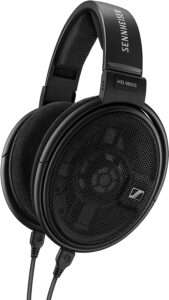
Imagine living in a world where every note of your favorite song or every word of the dialogue in your favorite movie is felt as well as heard, where even the most minute details in sound are brought to life with breathtaking clarity.
Thanks to the extraordinary Sennheiser HD 660 S, this world is not just a far-off fantasy in the world of audiophiles and music lovers. These headphones are more than just a means of listening; they are a doorway to a sonic world that will transform your perception of sound.
The Sennheiser HD 660 S, a masterpiece painstakingly created for those who demand nothing less than perfection in their pursuit of auditory bliss, is the subject of this exploration as we reveal its captivating world.
Key characteristics include:
- Open-Back Design: Provides a spacious and natural soundstage.
- 150 Impedance: Enough to be driven by the majority of devices.
- Dynamic drivers produce rich, detailed sound.
Pros:
- Excellent audio quality and a well-balanced sound signature.
- Fits well for long listening sessions.
- High-quality construction with replaceable parts.
Cons:
- Because of the open-back design, sound may leak.
- Some buyers may find the price to be too high.
B. Beyerdynamic DT 990 Pro headphones
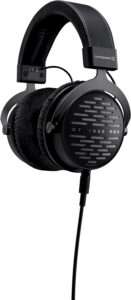
The pursuit of the ideal pair of headphones is both a passion and an obsession in the world of audiophiles, where every note, every nuances, and every whisper of sound are treasured and revered. Audiophiles are picky listeners who demand nothing less than perfection from their headphones.
Enter the Beyerdynamic DT 990 Pro, a pair of headphones that promises to provide an audio experience that is above and beyond the norm and whose name is recognized by audiophiles all over the world.
In this investigation, we delve into the world of these extraordinary headphones to learn more about them, analyze what makes them so alluring, and figure out why they have won the hearts and ears of audiophiles.
In order to experience a sonic journey unlike any other, let’s delve into the world of the Beyerdynamic DT 990 Pro headphones, where audiophile aspirations and audio purity meet.
Key characteristics include:
- Open-Back Design: Creates a large soundstage.
- 250 Impedance: Enough for a wide range of devices.
- Dynamic Tesla Drivers: Provide accurate audio reproduction.
Pros
- Audio that is clear and detailed, with a focus on the highs and mids.
- Ear cushions made of soft velour for extended wear.
- Durable construction with a tough headband.
Cons
- High impedance may necessitate a powerful source.
- For bass enthusiasts, the bass response may be less pronounced.
C. Audio-Technica ATH-M50x Headphone Model 3
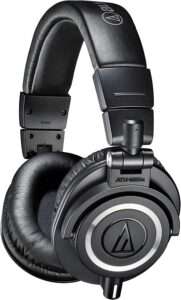
Key characteristics include:
- Closed-Back Noise isolation is provided for immersive listening.
- 38 Impedance: Smartphones and laptops can easily drive it.
- 40mm Drivers: Produce balanced, accurate sound.
Pros:
- Audio that is crisp and clear, suitable for a wide range of music genres.
- Design is collapsible for portability and storage.
- Cables are detachable for customization and easy replacement.
Cons:
- Soundstage is limited when compared to open-back headphones.
- During long sessions, ear cushions may become less comfortable.
D. Focal Elear Headphone Model 4
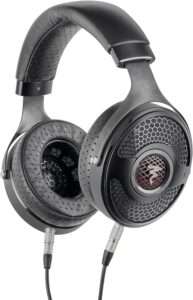
There is a realm that exists in the world of audiophiles and audio enthusiasts in which sound goes beyond the act of simply being listened to; instead, it transforms into an immersive journey, a symphony of emotions, and an exquisite art form.
Every note is a revelation in this realm because it combines the precision engineering with the sonic perfection. Welcome to the enchanted world of the “Focal Elear Audiophile” headphones, where the music you listen to stops being something you hear and instead becomes something you experience.
Step into a world where audio quality is not merely a preference but rather a passionate pursuit, and let’s investigate how these remarkable headphones redefine the very essence of music appreciation.
Key characteristics include:
- Open-Back Design: Creates a large soundstage.
- 80 Impedance: Compatible with a wide range of sources.
- Large 40mm drivers: Produce high-quality audio.
Pros:
- Sound clarity and detail are exceptional.
- High-quality construction with leather ear cushions.
- Fits well for extended listening sessions.
Cons:
- Price point is higher.
- An open-back design may not be appropriate for noisy environments.
E. Grado SR325e Headphone Model
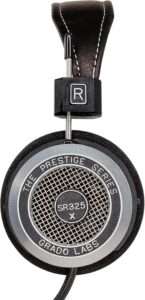
The name “Grado” is synonymous with unwavering craftsmanship and a dedication to providing the purest listening experience in the world of audio enthusiasts, where the pursuit of sonic perfection is a never-ending journey. Enter the Grado SR325e, a pair of headphones that has established itself as a prized gem in the collection of audiophiles.
Grado has built a devoted following of music enthusiasts and discriminating listeners thanks to its long history and reputation for creating some of the most sought-after headphones in the business.
In this investigation of the Grado SR325e, we set out on a sonic journey, digging into the construction, functionality, and distinctive personality of these headphones in an effort to comprehend what makes them a popular option among those who demand nothing less than the best from their audio equipment.
The Grado SR325e invites you to enter a world where music transcends sound and transforms into pure emotion, whether you’re an experienced audiophile or simply looking for an extraordinary listening experience.
Key characteristics include:
- Open-Back Design: Provides a spacious and airy soundstage.
- 32 Impedance: Compatible with the majority of devices.
- Dynamic Drivers: Produce dynamic, energetic sound.
Pros:
- Design that is one-of-a-kind and vintage-inspired.
- A distinct sound signature with an emphasis on the midrange.
- Handmade in the United States.
Cons:
- Due to the open-back design, noise isolation is limited.
- Not as comfortable for long periods of wear as other models.
5. How to Maximize the Performance of Your Amp-Free Audiophile Headphones
Now that you have chosen your amp-free audiophile headphones, it is time to make sure you are getting the most out of them in terms of enjoyment and performance. We will go over how to get the most out of your investment in high-quality headphones in this section.
A. An appropriate source and audio file quality
High-Resolution Audio: Listen to high-resolution audio files (e.g., FLAC or WAV) rather than compressed formats like MP3 whenever possible. High-resolution files retain more details and nuances.
High-quality audio sources, such as a dedicated music player or a computer with a good sound card, should be used. These sources can provide more accurate and cleaner audio.
B. Customization and Equalization
Experiment with the equalizer settings on your device to fine-tune the sound to your liking. Adjust the bass, treble, and midrange frequencies to get the sound you want.
Amp-Free Advantages: Appreciate the fact that amp-free headphones provide excellent sound quality without the use of additional equipment. Believe in their sound design and the research that went into it.
C. Noise Isolation and Environmental Considerations
Quiet Environment: To minimize external noise interference while critical listening, choose a quiet environment. Noise isolation is improved with closed-back headphones.
Noise-Cancelling Headphones or Accessories: If you frequently listen in noisy environments, consider noise-cancelling headphones or accessories. These can improve your listening experience even more.
Proper Fit: Make sure your headphones are properly fitted and form a good seal around your ears. This improves noise isolation while also improving bass response.
D. Upkeep and Repair
Cleanliness: Keep your headphones clean by wiping down the ear pads and headbands on a regular basis. To clean, use a soft, damp cloth. To avoid damaging delicate components, be gentle.
When not in use, keep your headphones in a protective case or pouch to avoid dust, scratches, and accidental damage.
E. Investigate Various Genres
Audiophile headphones are known for their ability to excel in a variety of music genres. Experiment with different genres to fully appreciate their adaptability.
Live Concerts: Listen to live concert recordings from the comfort of your headphones to experience the depth and authenticity of live music.
F. Transition Period
Patience: Some headphones benefit from a “break-in” period during which their sound may slightly improve. Allow some time for your headphones to settle in and reach their full potential.
G. Routine Checkups
Driver Inspection: Check for any driver issues or cable wear on a regular basis. To maintain peak performance, address any issues as soon as possible.
Following these guidelines, you can ensure that your amp-free audiophile headphones deliver the immersive and high-fidelity audio experiences they were designed for on a consistent basis. Enjoy the world of superb sound that these headphones bring to your music, movies, and other media.
Conclusion
Appreciate the nuances, experience the feelings, and take in the immersive soundscapes that these headphones, which do not require an amplifier, have to offer as you begin your journey as an audiophile.
These headphones allow you to enter a world of sonic splendor, regardless of whether you have previous experience as an audiophile or are just starting out in the world of high-fidelity audio.
Now is the time to get plugged in, tune in, and let yourself be consumed by the music. Your aural organs will be grateful to you for doing so.
Frequently Asked Questions
A. Can I use an amp with these headphones if I so desire?
Absolutely! While the headphones discussed in this guide are designed to sound great without an external amplifier, you can use one if you prefer.
Some listeners enjoy experimenting with various amplifiers in order to fine-tune the sound to their preferences. Simply make sure that the amplifier you select meets the impedance and sensitivity requirements of your headphones.
B. Do these headphones work well with various types of music?
Yes, the headphones in this guide are known for their versatility and ability to perform well with a variety of music genres.
These headphones are designed to provide a balanced and detailed listening experience, whether you enjoy classical, jazz, rock, electronic, or any other genre. To better match your preferred genre, you can adjust the sound signature using equalizer settings.



